This composer's style is rooted in vocal music. He has a liking for long, lyrical lines and textures of rhythmically fluid counterpoint, the whole frequently being inspired by extra-musical conceptions.
Few would recognize Elliott Carter in this description, yet it defines the core of his style. From the date of his first acknowledged composition, incidental music for Sophocles' Philoctetes (1933), to his first fully characteristic one, the Piano Sonata (1945-46), 15 out of 21 works are vocal. Of the eight instrumental works, three are descriptive of things outside of music, and almost all have strong vocal qualities.
By stressing song and choral music in his early years, Carter allied himself to the American musical past which is steeped in this tradition. It would be difficult to find many American composers of the twentieth century who began their career with so generous a concentration on vocal music. Does this preoccupation have an effect on his later, almost purely instrumental works? Very definitely. It anticipates recurrent characteristics of his mature art: (1) Lyricism, not in the tradition of song, but in the manner of the madrigal, an extended, supple contour. It is always present, although very subtly, in the works from the second string quartet on; (2) A texture of differently and irregularly scanned lines. Perhaps the most important developments in the composer's style will occur here; (3) Extra-musical inspiration. Carter has said many times that this is a springboard for his compositions. To the above must be added his deep concern for the essential characteristics—structural, acoustical, expressive—of the medium for which he is composing. Thus in writing incidental music for a Greek play, the composer studied Greek music and incorporated elements of it into the composition. In the Piano Sonata he exploited the peculiar sonorous capabilities of the instrument; and in the First String Quartet he seems to have been acutely conscious of the treatment of this genre as a conversation among four equals.
To understand Carter's development up to the Second String Quartet (1959), his first completely individual work, we must be aware of three overlapping lines of development. For the sake of convenience these may be labeled the Neoclassical, the Expressionist, and the Mature. These terms should not be thought of as definitive or mutually exclusive. They simply serve to bring to mind certain characteristics of Carter's music and to relate him to other composers. In the Neoclassical phase, his style is marked by a lean and economical texture, rhythmically-differentiated linear counterpoint, growth by motivic extension, a tonally-focused harmony, and adherence to formal stereotypes. Even though many of the compositions of this period are vocal or descriptive in origin, they are governed by abstract musical processes. These aspects obviously relate Carter to such figures as Copland and Stravinsky. The Expressionist phase modifies certain of the characteristics of the Neoclassical: the texture becomes more congested, free uses of serial techniques appear, tonality is loosened or dissolved, and there is more reliance on ad hoc forms. Here the music of Sessions and Schoenberg is touched on. The mature phase will incorporate and transform many of the traits of the earlier styles. At this stage the composer comes into profound contact with the musical worlds of Charles Ives and Debussy. The following chart will help clarify the above. Not all of Carter's compositions are listed, only the more signal ones and those initiating a phase.1 Those having characteristics of more than one phase will be listed under all the appropriate headings.
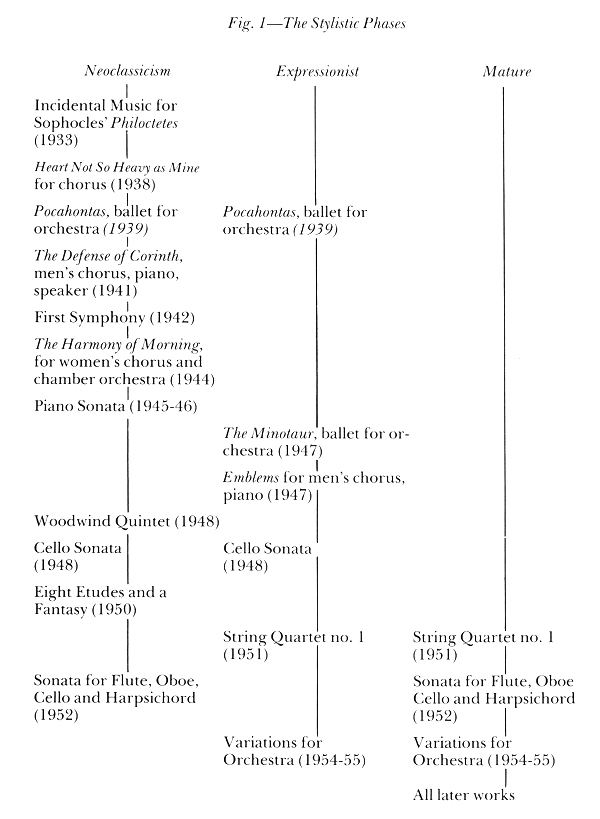
The vocal music of the early years ranges from the relatively simple melody and accompaniment of the songs and some of the early choral music to the complex counterpoint of Musicians Wrestle Everywhere (1945). The first work to reflect something of the individual Carter is his choral setting of Emily Dickinson's Heart Not So Heavy As Mine (1938). The skillful piling-up of different motives, some brilliantly and graphically evocative of the text, anticipates in a short span the characteristics of individual instruments in the later music. Each idea keeps a sharp identity even when mixed simultaneously with others. Perhaps the finest setting of this Neoclassical stage is a translucent The Harmony of Morning (1944) for women's voices and chamber orchestra. Its melodic grace, bright colors, and snappy rhythms reflect one side of the neoclassical aesthetic, and a genuine if not often recognized side of Carter's musical personality.
The instrumental music of this period is similar in general style to the vocal music, with a strong preference for linear textures. The early essays in large forms, such as Pocahontas (1939) and the First Symphony (1942), are confident and successful if not particularly individual. It is with his first work almost purely instrumental in inspiration, the Piano Sonata, that the mature composer begins to emerge. In two masterfully interrelated movements, working out a tonal opposition between B and A-sharp, with bold themes derived from the sonorous and technical characteristics of the piano, it is a distinguished and lasting contribution to the repertoire. From this point he begins to abandon the predictable formal procedures of the earlier compositions, musical contrasts start to be based on complex tempo and rhythmic differentiations, and the contrapuntal lines become ever more differentiated. The exploitation of instrumental idioms initiated by the Piano Sonata will remain a preoccupation of the composer, especially in the period 1945-50 with such works as the Cello Sonata (1948), the Eight Etudes and a Fantasy for woodwind quartet (1950) and the Pieces for Timpani (1949).
Elements of the Expressionist phase first appear in the ballet Pocahontas, but they will not emerge full-blown until The Minotaur (1947), Emblems (1947), the Cello Sonata, and above all the First String Quartet (1951). The Cello Sonata makes an interesting comparison to the Piano Sonata. It is a more arresting work, extraordinarily rich in thematic ideas. Like the earlier composition, this sonata grows intimately out of the sounding peculiarities of the medium, now two instruments. Added to this is the first prominent use of precisely measured, fluctuating tempos, generally referred to as "metrical modulation." From the structural point of view, however, it is less satisfactory than the Piano Sonata. The movement sequence is a conventional one, and each movement is in A-B-A form, a curiously mechanical choice given the boldness of the thematic process. The composer has not yet found a proper vehicle for his developing musical ideas. Some of this same uncertainty pervades the imposing First String Quartet. Its opening movement is the first in Carter's uvre to subordinate thematic structure to textural action. The larger structure is determined primarily by an oscillation between extreme independence of the four instruments and a more cooperative interplay. Contrast is also at the heart of the inner movements which simply juxtapose dramatically different thematic/textural blocks. The ultimate effect of these movements is somewhat stiff, as in the succession of A-B-A forms in the Cello Sonata. Thematic structure and textural action are held in balance in the variations-finale, which is given a deft ternary shape. Hovering between older formal shapes and new musical processes, this quartet gains a peculiar expressive quality from its own contradictions. These years still see some works which are best classified as neoclassical, such as the Woodwind Quintet (1948), Eight Etudes and a Fantasy for woodwind quartet, and the Sonata for Flute, Oboe, Cello, and Harpsichord (1952). There is a clarity and restraint about these works which preclude calling them expressionist; rather they are the maturest products of Carter's neoclassical genius.
The work which unmistakably ushers in the mature phase is the Variations for Orchestra (1954-55). It is the last work of Carter to show an easily recognizable contact with the past and the first to reveal all the essential qualities of his mature style. As such it is well worth some extended discussion. The composer himself has pointed out its basic structure.
The work is based on three musical ideas. The first two, ritornelli, are repeated literally here and there throughout the work in various transpositions of pitch and speed. The third is the central theme and undergoes many transformations. Of the ritornelli, the first, rising rapidly and played by the full orchestra shortly after the beginning, becomes progressively slower at each restatement (Variations I, III, VIII, and Finale). The second, played by two solo violins in a high register, descends quite slowly during the presentation of the main theme and becomes faster at each reappearance (Variations II, VII, and Finale). The material of the main theme is used in many ways, and its opening and closing motives are frequently referred to.
The larger plan consists of the presentation of degrees of contrast of character and their gradual neutralization during the first four variations. In the fifth, contrast is reduced to a minimum. From the sixth through ninth there is increasing definition and conflict of character, and the finale carries this concept even further.2
The large structure of the variations needs additional attention and Fig. No. 2 will aid the analysis. This is simply a sketch of the over-all shape of the composition and is meant to serve as a reference for the ensuing discussion.
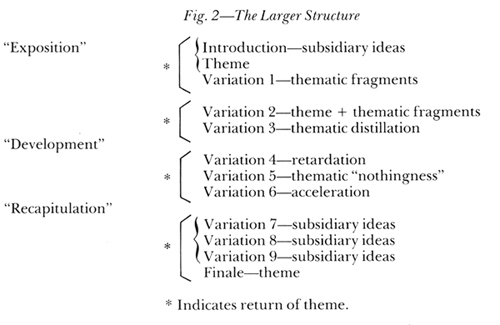
The disappearance of the theme and its eventual transformed restatement is not uncommon in variation sets. Similar examples may be found in Beethoven's Eroica Variations, Opus 35 and Reger's Variations and Fugue on a Theme of Mozart, Opus 132. The return of the theme is an important, culminating event, thus the analogy to sonata form. Symmetry, in this case occurring between the "exposition" and the "recapitulation" and within the "development" (with the relatively static central variation surrounded by retarding and accelerating variations), will become a recurrent characteristic of the movement sequence in Carter's later works. Since the harmonic materials of the variations are derived from the intervallic structure of the theme, the periodic return of the theme—either fairly intact as in variation 2, broken into chords as in variation 5, or with the rhythm changed as in the Finale—acts as a kind of tonal return.
As Carter points out in his brief analysis, the introduction presents two recurrent thematic elements which he terms ritornelli. The first of these may be described as an ascending, leaping melodic figure frequently associated with an accelerating rhythm; the second as a generally descending stepwise line in a regular, slow rhythm. The first ritornello becomes progressively slower throughout the variations, the second becomes progressively faster (Ex. 1).
Ex. 1. Variations
#1) M. 8-27
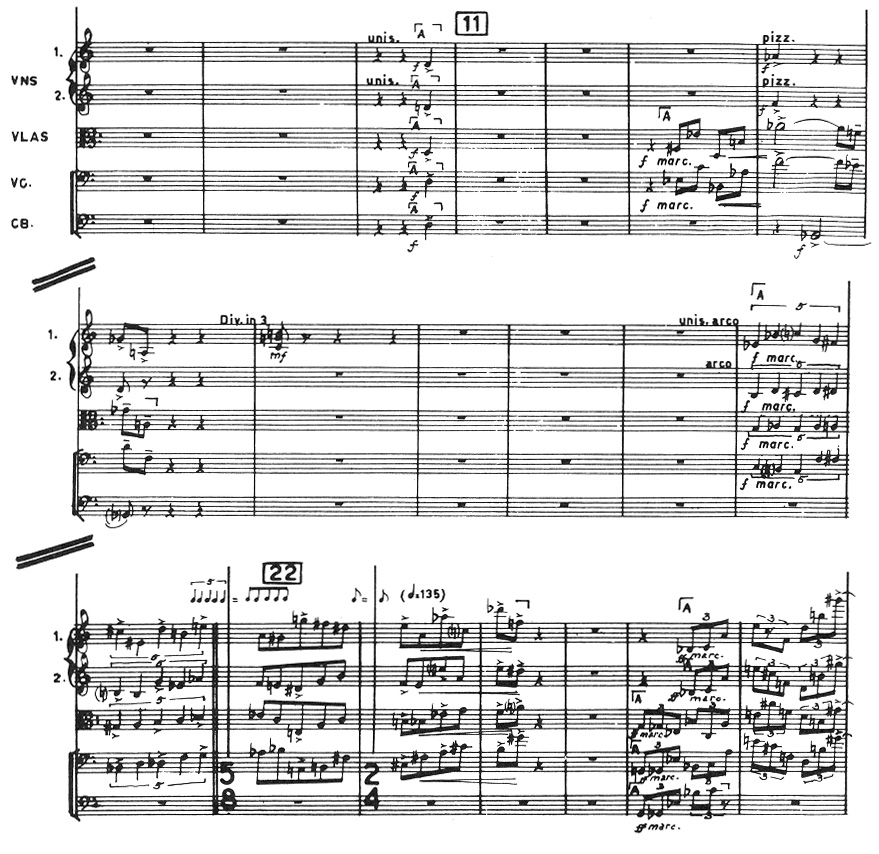
#2) M. 39-46

However, in addition to these ritornelli and the theme, there are two other musical ideas which play an important role in the composition. The first appears at the very beginning and may be described simply as "chords"; the second appears shortly thereafter, and may be called a "scherzo rhythm." It is generally brisk in tempo and involves a triple subdivision in a prevailing duple meter (Ex. 2).
Ex. 2 Variations
"Chords"
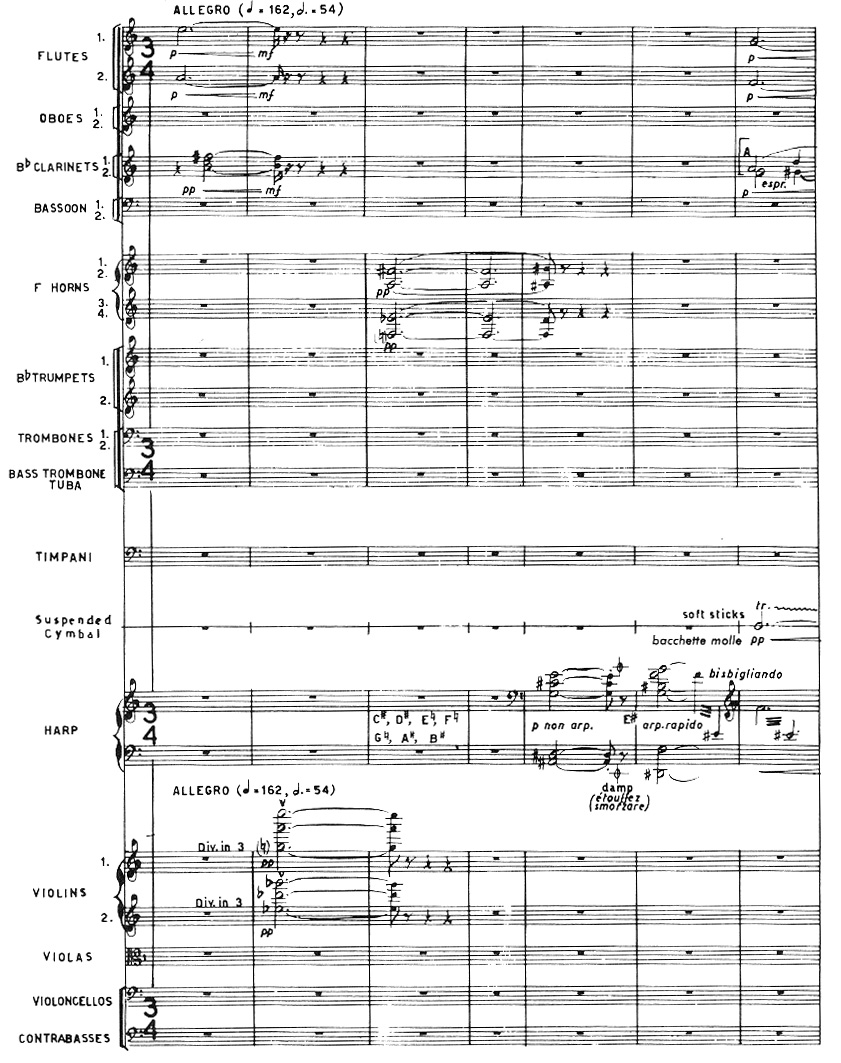
"Scherzo Rhythm"
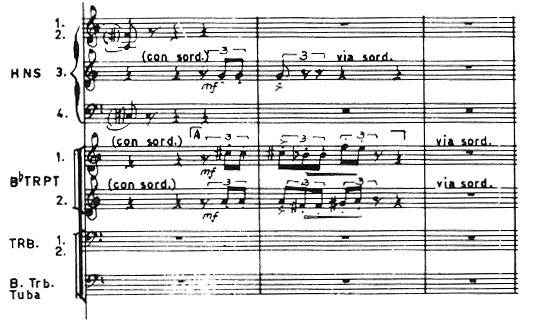
Furthermore, the composer at times abstracts from the second ritornello and the theme a common quality which may be termed "lyricism." He also establishes a common bond between the first ritornello and the scherzo rhythm by means of their rhythmic similarities. Notice that these qualities—chords, scherzo rhythms, and lyricism—are far less tangible elements than the two ritornelli and the theme. It is precisely because of this that they are so significant. Carter's later music will not be concerned with themes in the traditional sense, but with assemblies of musical fragments tossed at each other. I will call these assemblies "character-complexes." The beginnings of these are to be found in the Variations for Orchestra.
All the recurrent elements of the Variations, therefore, are presented within the introduction and theme. The character of each individual part of the work will be determined by its particular mix of these elements. Within this first section the ascending, leaping figure dominates the introduction, and the quality of lyricism dominates the theme. The scherzo rhythm, only hinted at in the introduction, occurs as punctuation between the many phrases of the theme. All of these musical characters are kept detached, aurally speaking, from one another by either spatial or temporal means.
This separateness between musical characters is broken down in variation 1. Motivic fragments and isolated phrases of the theme are interlocked with the scherzo rhythm and the first ritornello to produce a primarily rhythmic variation marked by a general absence of lyricism (Ex. 3).
Ex. 3. Variations
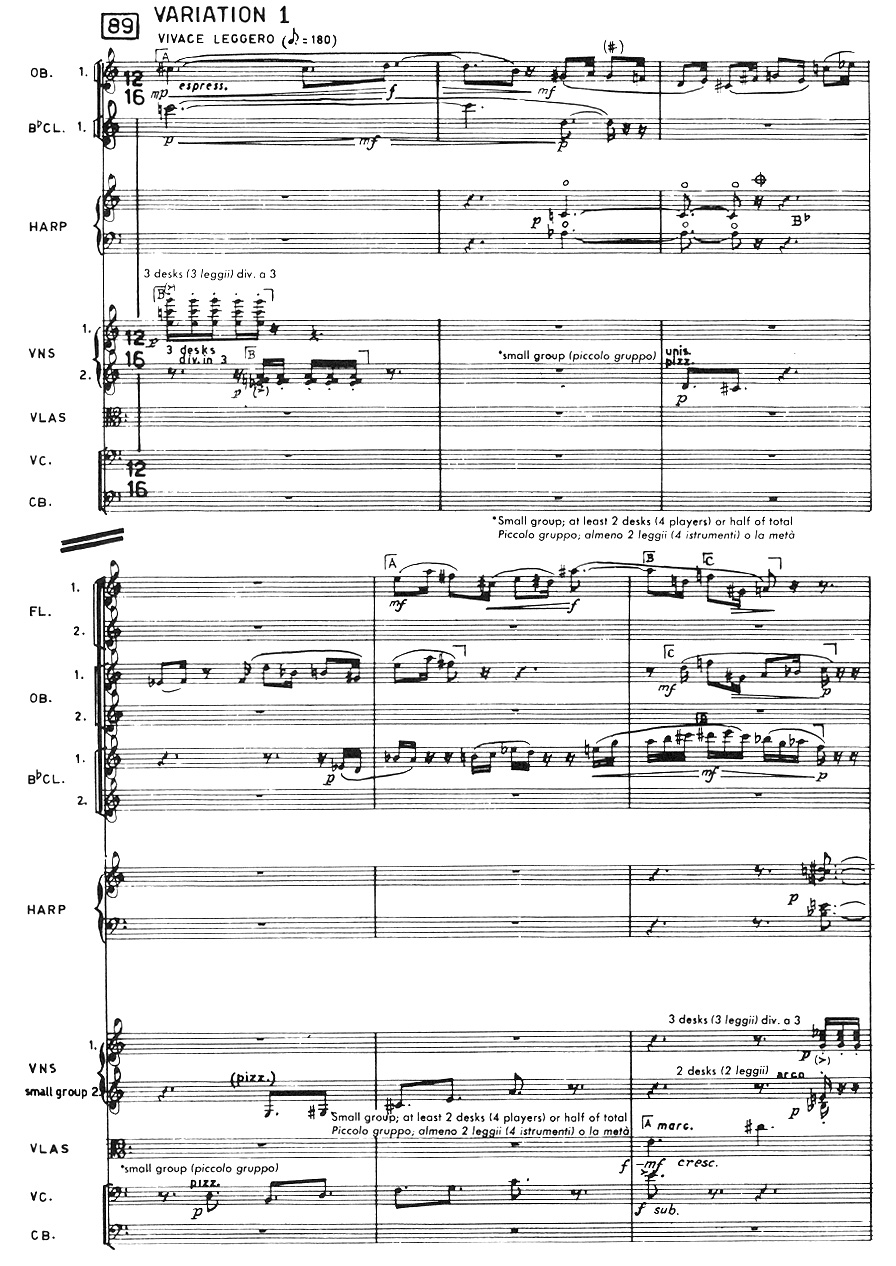
Twice towards the end of the variation this prevailing character is changed by the appearance of the chords (measures 109-115, 125-128). Apart from the obvious cadential effect, they serve to close off this unit by referring back to the chords which open the work.
Variations 2 and 3 parallel the introduction and theme, and variation 1. In variation 2 the theme is presented again, in the brass, surrounded by many of the fragmentary ideas of variation 1 (Ex. 4).
Ex. 4. Variations
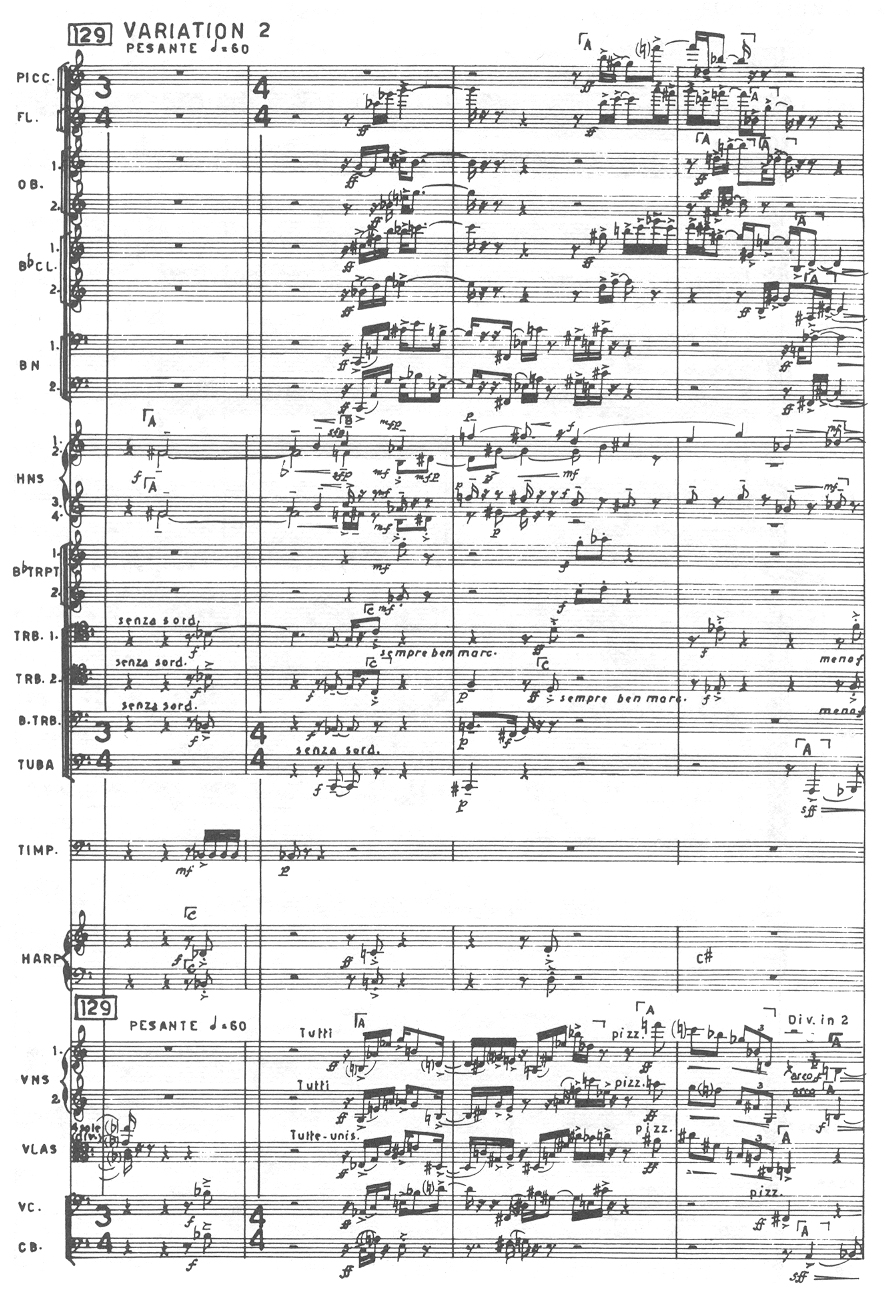
Variation 3 presents various thematic components, but rather than whirling them together as variation 1 does, it separates them distinctly. The musical characters, chords and lyricism, are brought into the sharpest possible focus, presenting the first case of a melody-plus-accompaniment texture (Ex. 5).
Ex. 5. Variations
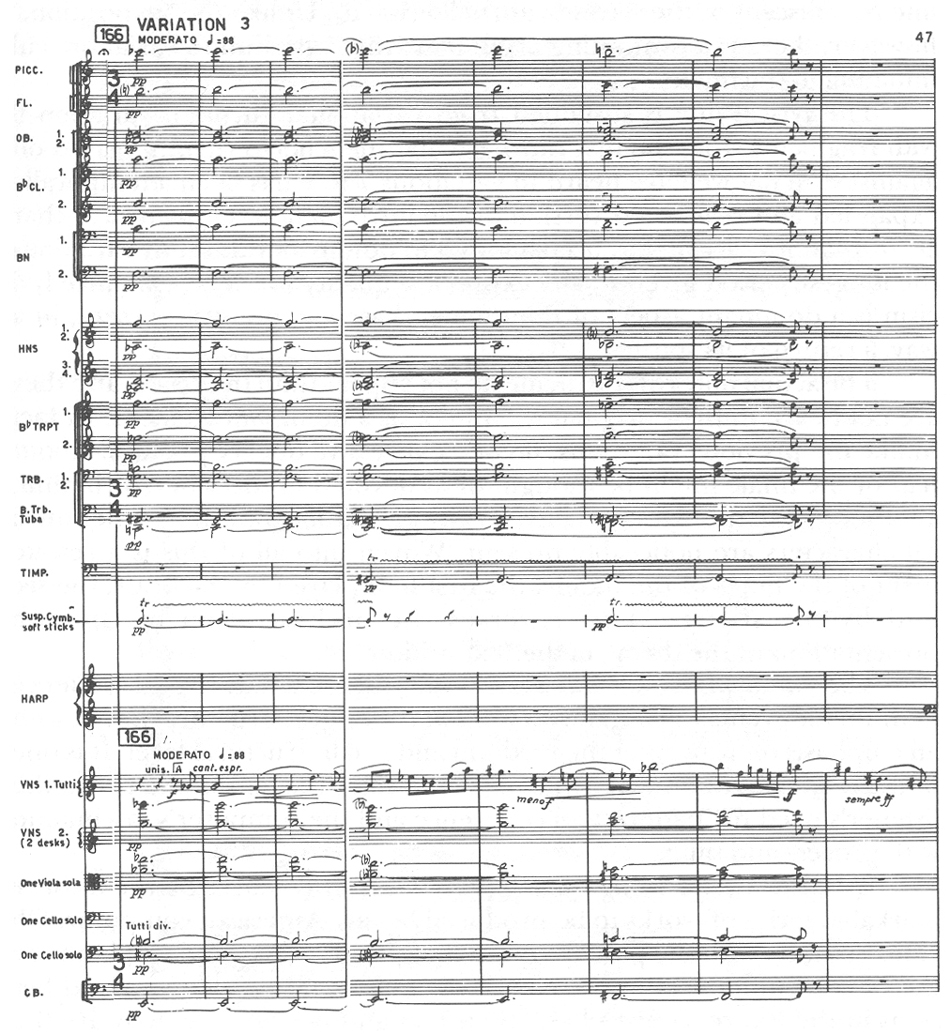
Between the statements of this texture occur the scherzo rhythm and a slight suggestion of the first ritornello (measures 176-181). The latter very clearly takes over the variation at measure 196.
What has been called the "development"—variations 4, 5, and 6—brings in a direct and vivid way the slowing down, cessation and resumption of musical activity. Variations 4 and 6 bring into play Carter's most famous musical technique—metrical modulation. In no other way could variation 5, presenting the notes of the theme in almost motionless chords, be so effectively highlighted. Successive retardations of musical lines (variation 4) lead into this musical still-point and successive accelerations (variation 6) out of it.
The beginning of the "recapitulation" recalls quite distinctly the opening of the variations. The chords briefly echo through the groups of the orchestra. The first ritornello quickly follows, to be joined by a lyrical line reminiscent of the second ritornello (Ex. 6).
Ex. 6. Variations
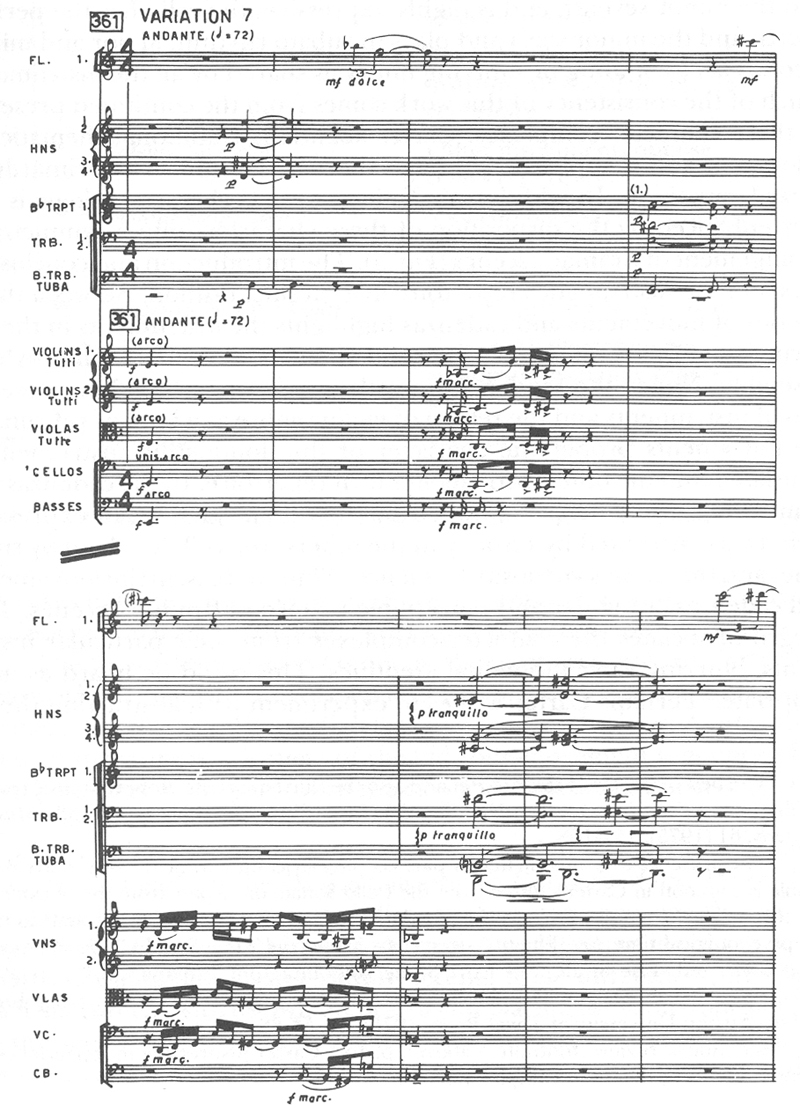
Unlike the "exposition," however, there is a continuing argument from variation to variation, culminating in the finale.
The lyrical line is sustained from variation 7 through variation 9, with fragments from the first ritornello and the scherzo rhythm played off against it. What we have heard in variations 7 to 9 has been a temporally expanded and reassorted version of the introduction. One musical character, that of lyricism, has been allowed to dominate this set of variations, the longest period given to any expressive quality in the work. Since lyricism is a dominant aspect of the theme, these variations represent, in a way, a return of its spirit.
The actual notes of the theme do not appear until the finale, and they are not heard in their original rhythm or as a dominant element. In fact, unlike the previous variations, no one expressive quality prevails. About half of the finale might be thought of as devoted to the scherzo rhythm; another half to the "lyric" quality. At any given time, however, other musical characters are noticeably present. Woven into all of this is a restatement of the notes of the theme, the first half played by the brass, the second by the strings. This reverses the orchestration of the two presentations of the theme in the "exposition."
The Variations establishes a tactic that will remain. A logical sequence of dramatic events will organize a work at the largest structural level, with an emphasis on process at the medium and small structural level. It is one of the strategies that Carter will employ to solve the tensions between the listener's need for pattern and coherence and the composer's fascination with process and time.
With the Second String Quartet (1959) Carter embarks on the most remarkable series of works to be produced by any American composer. Obvious contacts with the past are now gone. If Stravinsky and Copland are the clearest influences in the Neoclassic phase and Schoenberg and Sessions in the Expressionist phase, then Ives and perhaps Debussy are the choices for this phase. Carter is the only American composer to assimilate Ives's dramatic scenarios and colliding musical worlds and produce something distinctively his own. A comparison of the two composers is beyond the scope of this article, but the essential difference lies in Carter's structural control. No event is random.
The First String Quartet had put considerable emphasis on the individuality of each of the instruments. This is of course almost a matter of doctrine for this genre. The Second String Quartet carries this individuality to the furthest extreme.3 Each instrument is assigned its own repertoire of intervals, rhythmic character, and expressive personality. The first violin is given the minor third and the perfect fifth, and is virtuosic in character; the second violin has the major third, the major sixth, and the major seventh, maintains strict time and is often pizzicato;4 the viola has the tritone and the minor seventh and is highly expressive; the cello has the perfect fourth and the minor sixth and plays in rubato rhythm. Major and minor seconds act as binding or unifying intervals shared by all the instruments. Much of the consistency of this work comes from the continued presence of these character-complexes. Carter abandons traditional thematic development and recurrence, although there is skillful use of primarily localized repetition. In addition to distinct musical characters, logic is further enhanced by the disposition of these characters into a symmetrical arrangement of dramatic scenes (Fig. 3).
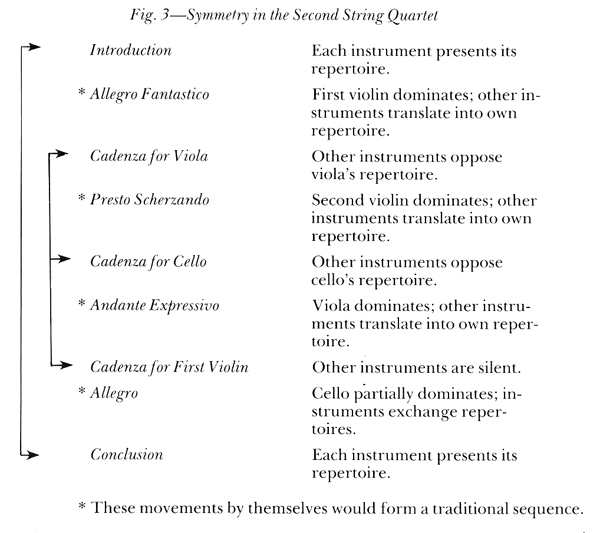
The introduction and conclusion present each instrument's repertoire in a succinct fashion. Between these a series of movements and cadenzas highlights the instruments in the following way: first violin—viola—second violin—cello—first violin—whole ensemble. Notice the tendency towards an alternate high/low presentation of instruments and the return of violin timbre as a kind of refrain. In the movements proper the character of the dominating instrument is translated into the other instrument's own repertoire. In the cadenzas the dominating instrument is opposed by the others; the viola's expressive melody is confronted by ferocity in the others; the cello's rubato by strict time; and the violin's virtuosity by silence. Thus there is, in the movements and cadenzas, a regular and perceptible pattern of dramatic scenes. The allegro dissociates the character-complexes from their particular instruments, blurring their individual identities. This could be heard as inappropriate.5 Perhaps Carter wishes to experiment with abstracting the expressive character from its concrete instrumental associations. At any rate he does not do it again; the later works will keep repertoires separate.
The Second String Quartet is one of the most accessible of Carter's mature works. Its compactness, open and audible texture, and direct expressiveness should appeal immediately to any sensitive listener. As novel as its musical structure is, whispers of the old four-movement sequence of the string quartets of the past touch the ears with delicate but firm impact.
The individualization of instrumental characters and their presentation in an orderly series of dramatic scenes are clothed in a rich and varied instrumental garb in the Double Concerto for Harpsichord and Piano (1959-61). Here there is a pronounced disparity in nature between the two solo instruments. One is plucked, one is struck. One is limited in volume, one is relatively unlimited. Carter simply accepts these differences, providing each instrument with its own orchestra and placing them on opposite sides of the stage. This is not the whole of the musical characterization, however, since the individual orchestras are disposed into pitched and unpitched instruments with the soloists acting as mediators between the two. This is the first use of a mediator in Carter's list of characters. Since both soloists can be considered pitched percussion instruments (admittedly stretching the concept a bit for the harpsichord), they are ideal for the role.
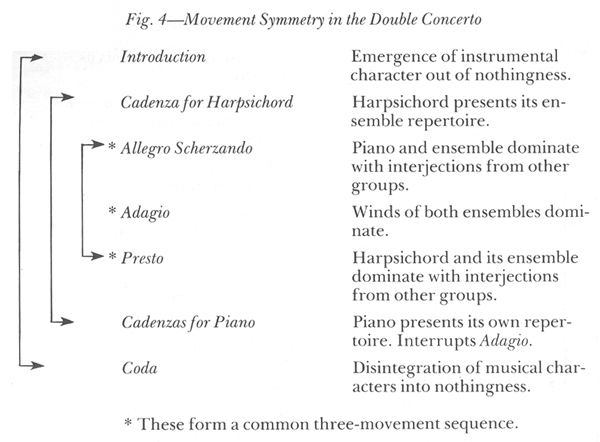
The presentation of the "scenes" is the most symmetrical in Carter's uvre. Like the Second String Quartet an introduction and a conclusion present the cast of musical characters with their particular musical languages. Taking advantage of the variety of musical instruments, the composer shows a musical world in creation and disintegration.
Starting with nonpitched instruments, the introduction gradually brings in the pitched instruments until the two soloists and their respective orchestras diverge in identity. The conclusion—or coda as it is called here—presents this process in reverse, although much more suddenly. The cadenza for harpsichord allows that instrument to present the particular language of its ensemble; the cadenzas for piano are based on that instrument's own language. As in the Second String Quartet there is at the heart of the series a standard movement sequence, in this case fast-slow-fast. In the Allegro scherzando the piano and its ensemble dominate, with the others breaking in. In the Presto the opposite is the case (and also the percussion instruments are absent). The Adagio, one of the most beautiful slow movements in Carter's work, highlights the wind instruments of both orchestras, surrounded by a halo of strings, percussion, and the two soloists in accelerating and decelerating patterns. At the conclusion of this movement the two instruments play a duet, the harpsichord decelerating and the piano accelerating, the simplest confrontation in the concerto and archetype of the interplay of independent lines which characterize the work.
The essential consistency of the concerto, as in the Second String Quartet, depends not on thematic return or development but on the maintenance of consistent instrumental characters. Each of the two performing groups has its own repertoire of intervals, rhythms, and speeds. Their control, however, is even more precise than in the earlier work. The twelve pitches of the chromatic scale are disposed into a limited number of complex chords divided between the two groups. These chords are further broken down into characteristic intervals and these intervals are associated with certain instruments, rhythms, and tempos.6 Thus there is a consistency in the harmonic structure and this consistency is ultimately associated with instrumental characters and individuality of rhythm and pace. This technique is obviously similar to integral serialism but the latter is generally applied to much larger patterns with permutations that limit its audibility. Carter's practice is eminently audible, since it applies to much smaller motivic-rhythmic-tempo units which remain associated with certain instruments. These musical atoms I have called character-complexes.
The Variations for Orchestra, the Second String Quartet, and the Double Concerto are all closely linked in that they share the same approach to balancing the demands of pattern and process. In each there is a symmetrical movement or section plan organized as a series of dramatic scenes—"scenarios" as the composer has called them. At lower structural levels, process reigns. The emphasis is on a free interplay of nuclear thematic units governed by a sophisticated, irregular, and nonlinear sense of time's passage.
With his next work, the Piano Concerto (1964-65), process invades all levels of the musical structure. Perhaps because this is a less complex medium than the Double Concerto, the dramatic relationships are handled in a simpler fashion. Rather than have the piano cooperate with the orchestra as with Mozart, or dominate it as with the Romantic composers, Carter places the two in stark opposition. The orchestra is a rather inflexible massed group, the piano a nervous unstable individual. So that the work is not simply a clash between incompatible characters, Carter adds a mediator, a concept first used in the Double Concerto. This mediator is a concertino of seven solo instruments: flute, English horn, bass clarinet, violin, viola, cello and bass, whose character may lean in the direction of either the orchestra or the piano. These three performing units are bound together by their relationships to a central fund of pitches. One twelve-tone chord is assigned to the orchestra, one to the concertino and soloist. From the respective twelve-tone chords, six triads are derived for the orchestra and six for the concertino and soloist. Each triad highlights a particular interval.7 As in the Double Concerto, pitch groups are associated with characteristic rhythms and speeds. What makes the Piano Concerto more than a simpler, differently colored version of the Double Concerto is the abandonment of a symmetrical movement sequence. There are two movements. In the first the piano and the concertino dominate with a very light and subtly colored texture; in the second the piano is brutally assailed by the massed orchestra but ultimately triumphs.
As simple as the plan of this concerto is, it is perhaps the most difficult of all Carter's compositions to grasp. The reliance on dramatic interplay to the neglect of any schematic repetition plunges the listener into the raw stream of time with an energy worthy of James Joyce. Yet for the patient listener there are many rewards. The delicate interaction between piano and concertino is frankly romantic in tone, as is the confrontation between piano and orchestra in the second movement. It is a work best enjoyed by living in the beauty of the present moment. Only once again does the composer essay a work so ruled by action, the Duo for Violin and Piano.
If the Piano Concerto is essentially a simplification of earlier procedures, the Concerto for Orchestra (1969) introduces a major new technique: simultaneous movements. Carter's music is built on one of the fundamental characteristics of Western music, the simultaneity of musical characters, or as it is usually called, counterpoint. The use of several successive movements of differing characters can easily be seen as an extension of this principle. Thus what the composer is doing here is collapsing these two principles into one. The four movements of the Concerto for Orchestra are distinguished by their tessitura, musical character and tempo, and instrumentation. The first movement occupies the lower middle register, maintains a moderately fast tempo, is characterized by decelerating phrases, and includes the cello section, piano, harp, marimba, xylophone, and wooden percussion. The second movement is in the high register, starts fast and gradually becomes slower, and encompasses high strings, high winds, and metal percussion instruments. The third is set in the low pitch range, is similar to recitative in its expressive character, is composed of accelerating phrases, and features the basses, horns, tuba and some other low pitched instruments. The fourth is in the medium high register, starts slowly and then becomes more rapid in tempo, and uses the violas, trumpets, snare drums, and other appropriate instruments. These movements are treated in much the same way that four contrapuntal lines would be, now one, now the other being highlighted. The general progress of the work is not hard to follow since the movements are emphasized in the same order in which I have described them. For instance after a general outbreak of the orchestra at the beginning, the first movement is heard in the foreground with the others counterpointing it. Then the second movement comes to the fore, and so on. Carter's use of sharp rhythmic differences and metrical modulation between layers only reinforces the concept of these simultaneous movements as a kind of thickened counterpoint. This basic sonic texture is greatly enriched and complicated by treating the various instruments in each movement in a soloistic or contrapuntal manner. Thus we have counterpoint within counterpoint, musical characters within musical characters.
Control of the pitch material is similar to the preceding concertos. A central fund of pitches is distributed between the movements and becomes intimately related to their individual expressive characteristics. Five-tone chords and their smaller and larger relatives form the harmonic core of the Concerto for Orchestra, giving it a leaner, more astringent sound than the densely chromatic Piano Concerto.8
Initially confusing, the Concerto for Orchestra becomes increasingly transparent on repeated listenings. The various movements' sounds are distinctive and soon remembered, and the ear follows their interplay with fascination. The implied interaction between movements which is a part of any traditionally sequential cyclic work is here made simply more explicit.
The Canon for Three (1971) is an occasional work which brings nothing new to Carter's music, but the Third String Quartet (1971) must be counted one of his finest works. It sums up in brilliant and highly audible fashion the major achievements of his mature phase, and presents what becomes a favored solution to the demands of pattern and process. As has been said, one of the characteristics of the composer's style is a texture of differently and irregularly scanned lines. All facets of the composer's use of this concept are clearly presented in this quartet. Within the two duos—first violin/cello, second violin/viola—into which the players are separated there is generally considerable contrapuntal independence. Between the duos as well there is the same distinction. The first duo plays rubato, the second keeps strict time. Rarely, for instance, do they have a simultaneous downbeat. The opposition and interplay of musical characters is—as in the Concerto for Orchestra—extended to the movement sequence. Each duo has its own set of movements, four for duo I and six for duo II. These movements are heard either alone (all ten appear this way) or in overlapping sequence, so that a new one begins while an old one is sounding. All possible pairings of the movements are played, and the succession within each duo is systematic.9 Since each movement may be considered a character-complex, we have an unusual opportunity to absorb this aspect of Carter's music. Tempos, expressive character, and intervals are all related. In duo I the Furioso movement emphasizes the major seventh, the Leggerissimo the perfect fourth, the Andante espressivo the minor sixth, and the Pizzicato giocoso the minor third. In duo II the Maestoso movement emphasizes the perfect fifth, the Grazioso the minor seventh, the Pizzicato giusto, meccanico the augmented fourth, the Scorrevole the minor second, the Largo tranquillo the major third, and the Appassionato the major sixth. The unused major second functions as a binding element, in a manner similar to the major and minor seconds in the second quartet.
As in the Piano Concerto all levels of the structure are in motion, without clear-cut repetition. If we were to take each cycle of movements by itself, there would be obvious recurrence; but by playing two cycles against each other, the effect is marvelously fluid and at the same time reassuring because there is perceptible repetition. A mere detailing of the overlappings and repetition would do little to convey the extraordinary expressive flexibility which they make possible. Movements of similar character may reinforce each other; ones of differing character collide. There is no nuance left unexplored. So satisfactory a solution to the larger structure are these coexisting sets of movements, Carter has used them for several of his later instrumental works.
Something of a chamber music twin of the Piano Concerto is the Duo for Violin and Piano (1973-74), the most direct statement of the essentials of Carter's music: the derivation of musical ideas from the individual natures of instruments. It is also reminiscent of the Cello Sonata but without that work's reliance on traditional formal procedures. There are no movements; there is no thematic repetition. There is nothing but two individuals speaking their own characteristic languages. The piano strikes its strings; control over the sound is over once the hammer hits. The violin bows its strings; the sound can be minutely controlled. The piano has a wider range and dynamic capacity than the violin. The violin is capable of far more idiosyncratic tonal attack and articulation. As so frequently in this composer's music, one member of the pair keeps fairly strict time (piano) while the other is very flexible (violin). What ensures the unity of the resulting work? There is much intervallic material in common, and there is a plausible curve of dramatic tension; but I think much of the unity comes from the listener simply perceiving the two different idioms occurring together. This is true of much of Carter's music; the listener must be an active participant in his compositions. A person watching a busy city through a window unifies its spatial and temporal events in his mind.
Since so many of Carter's ideas are derived from the particularities of instruments, simply changing the performing group will produce different music. The Brass Quintet (1974) brings an entirely new sound into his music, although the methods of composition are by now familiar. There are 19 short sections or movements which appear alone or overlap, as in the third string quartet. Rather than using a set sequence of movements that repeat in various ways, there is a set sequence of musical activities. Every third movement, called a quodlibet, shows the five instruments opposing each other with parts of their individual repertoires. In between there are duos and trios in which the various instruments cooperate with the same musical ideas. Thus there is an alternate separation and conjunction of musical repertoires, a more flexible procedure than that found in the second or third string quartets, or the Double Concerto, for instance. The association of intervals, rhythms, and tempos with the expressive personalities of individual instruments is also a part of the Brass Quintet.
The decade of the 1970s was an exceptionally productive one for Carter. There were three times the number of compositions written during the 1960s.10 It is the yield of a man who has mastered his technique, a technique forged with awesome effort. Not only is there greater fluency in the writing, but a pronounced lightening as well. If any works will assure Carter popularity with a wider audience, it will be such music as A Mirror on Which to Dwell, A Symphony of Three Orchestras and Syringa. With these the earlier interest in vocal music and extra-musical reverberations recurs. Not that it has been altogether absent in the works of the mature phase. Lucretius' De rerum natura and Pope's Dunciad provided convenient analogues to explain aspects of the Double Concerto and St. John Perse's Vents some initial inspiration for the Concerto for Orchestra. We should not give these relationships undue importance since they did not affect the actual structure of the works, but they do show that the composer's thinking about the music was not purely abstract.
A song cycle is by its very nature extra-musical in inspiration. The poems of Elizabeth Bishop that form the cycle A Mirror on Which to Dwell (1975) provide the wide scope for both pictorial and structural responses from the music. The poems are arranged so that they are alternately descriptive and emotional, and they are well complemented by Carter's essentially dramatic style. The bustling bells, birds, and whistles are vividly evoked at the beginning of "Anaphora," only to be choked off as the joy of morning descends to the weariness of evening. In "Sandpiper" the bird's song and movements are picturesquely suggested by the oboe while the long beach and lapping water may be identified with the bass, cello, and low chords in the piano. The half-heard band of "View of the Capitol" breaks through the prevailing music with an almost hallucinatory wit. These are far from pictorial responses since they affect the deepest aspect of the music, its projection of time. Without the mastery of rhythm gained over many years, the seemingly effortless contrast of gerrymandering sandpiper and to-and-fro waves, the magic of a vanishing band would not have been possible. Rhythm and evocative tone color are also at the heart of the less descriptive, emotional poems. For the initiate to Carter's music there is no better starting place than these songs. As structurally subtle and complex as any of his music, they are nevertheless simply approachable as brilliant readings of arresting poems.
At first glance A Symphony of Three Orchestras (1976) would seem far removed from a song cycle but it has a close relationship to Hart Crane's poem "The Bridge." His interest in this poem goes back to the 1930s when he projected an oratorio based on it. Many of the symphony's musical ideas derive from its images. The opening high, steely violin chords and the plunging passage for solo trumpet represent the bridge soaring high over the water with a seagull winging about. Shortly thereafter the Rip van Winkle episode is portrayed by the traditional clowns of the orchestra, the bassoons. In other musical respects, the work is something of an orchestral version of the third string quartet. There are three orchestras, one on the right consisting of triple woodwinds (less clarinets), two horns, strings (less cellos) and unpitched percussion (principally metallic)—one on the left consisting of brasses, strings and kettledrums—and one in the center consisting of three clarinets, vibraphone, xylophone, marimba, chimes, long drum, tom-tom, and a few strings. This center orchestra is a concertino and is characterized by rubato rhythm. Each orchestra has four movements, played twice in different orders, with variations. As in the third quartet, these movements generally overlap, with one occasionally being heard alone. Framing their interplay are introductory and concluding sections in which the music assembles and then breaks down. These movements are again character-complexes, being bundles of chords, intervals, tempo, rhythm, and expressive character. All are related to a 45-note "tonic" chord which forms the structural stem of the work. Emphasis on this chord moves from top to bottom as the symphony proceeds, much like a light panning over a tree. Each movement is built on a three-note chord and interval derived via four twelve-note all-interval chords from this central column of pitches. Although this description makes the symphony sound impenetrably dense, it is the airiest and most colorful of all Carter's orchestral compositions. It is with this work that a certain kinship with Debussy becomes most apparent. There is the same concern with shifting, evanescent process, the use of texture and timbre as a structural core, the avoidance of closed thematic material, the subtle use of evolving motives, but—and the difference is a crucial one—a far more energetic, one would almost say flamboyant sense of rhetoric.
To listen to these recent compositions in short succession is to be dazzled by their composer's singular musical imagination. Carter's seventieth birthday piece, Syringa (1978), is as distinctive as any in his uvre.11 His ability to translate the twentieth-century poem into an appropriate musical structure is unsurpassed, as his presentation of the bivocality of John Ashbery's poem shows. Meditating on death, objectified in the myth of Orpheus, the poet interweaves a quiet voice, accepting of time's flow, with an elegiac one, passionate and resistant to time. To dramatize these voices Carter contrasts a calm, graceful, smoothly flowing line for mezzo-soprano with a rhythmically agitated, mournful, almost archaic line for bass. Rather than trying to pick out the two voices intertwined in Ashbery's text, the composer assigns the poem to the upper voice and selected texts from the ancient Greek to the lower one, ranging from Sappho to Heraclitus. These passages pick up the elegiac tone and represent the resonance of past writings, the undertones of old Greece, that might flow through the mind of an educated reader. They are also a striking illustration of the Freudian subconscious; their assignment to the bass, the sub-voice as it were, is a delightfully appropriate, almost naive touch, something not uncommon in Carter. The instrumental ensemble is all weighted towards the bass: guitar, violin, cello, bass, alto flute, bass clarinet, English horn, piano and percussion. As a result the mezzo-soprano is sonically isolated, something which ensures audibility of the text and interestingly ranges the music on the side of the subliminal. As novel as this setting is, it has deep roots in Romantic song. There also the voice's primary role is to declaim the text; the piano sounds the unsayable.
The setting flows through time with no repetitions, not even the lapping, eddying reiterations of movements familiar from the third string quartet, and A Symphony of Three Orchestras. Although seemingly unique among Carter's works, Syringa actually has close relationships with works such as the Piano Concerto and particularly the Duo for Violin and Piano with its seamless projection of two personalities. The two poetic streams do not remain strictly parallel, however, but at times converge by means of bilingual similarities, when sounds of the two languages echo each other. The differences between this poetic setting and the early songs is as wide as any in the history of music. Few composers have traveled so far.12
Looking over the composer's compositions as a whole, it can be seen that those phases labeled neoclassical and expressionist are not set aside but subsumed into the mature phase, if by the former is meant a concern with structure and by the latter with drama. Of course it is not unusual for a composer to maintain a consistency of artistic outlook throughout his musical production. What is rare is for him to do so in ever new ways. Because of his exceptional creativity Carter can be likened to such composers as Josquin, Bach, Beethoven and Mahler, and not only because of his creativity but also because of his deep contacts with the traditions of Western music since the Renaissance. He is perhaps the only composer of his generation to maintain his contacts with the pastand also to renew them. While many composers were surrendering their compositional control to mathematics or to chance, he reasserted his freedom to choose, and his choice was intimately related to those fundamental characteristics mentioned above: structure and drama. The Western composer's concern with structure stems from the fact that his music is polyphonic. This presents problems of unity and variety not often found in other cultures. Carter begins with the underlying concept of distinguishing between the simultaneous musical lines and carries it to the furthest possible point with cross rhythms and differing and changing tempos. When the counterpoint of individual lines was exhausted, he moved to a counterpoint of movements. The other touchstone of his style—drama—is just as basic to Western music. It is a music of events, simultaneous and successive, and a music which tries to affect human emotions. It was Carter's realization that this drama is bound up with the individuality of the musical gestures—complex clusters of intervals, rhythm, tempo, and articulation—that enabled him to abandon traditional formal procedures. Intelligibility can simply come from the interplay of audible musical characters, characters rooted in the nature of their sounding medium. The composer has shown us possibilities in our tradition that many might have thought no longer existed.
Elliott Carter Variations for Orchestra Copyright © 1957, 1958 by Associated Music Publishers, Inc. Excerpts used by permission.
1A more detailed discussion of the early works can be found in Abraham Skulsky, American Composers Alliance Bulletin, Vol. 3, No. 2 (1957), pp. 2-11; and Richard Franko Goldman, "The Music of Elliott Carter," Musical Quarterly 43 (1957), 151-70.
2Record liner notes, Columbia Recording MS 7191.
3The best overview of this quartet and also the third quartet is Robert Moevs' review of Elliott Carter's String Quartets Nos. 2 and 3 (Recording, Columbia MS 32738), Musical Quarterly 61 (1975), 157-168.
4The presence of a musical line or part keeping strict time while the others are more flexible is common in Carter's music from the Cello Sonata on. Apart from the obvious aid to a correct performance, this practice is related to his conception of mathematical time and psychological time. See Elliott Carter, "Music and the Time Screen," The Writings of Elliott Carter, ed. Else Stone and Kurt Stone (Bloomington: Indiana University Press, 1977), pp. 343-365. Originally published in Current Thought in Musicology, ed. John W. Grubbs (Austin: University of Texas Press, 1976), pp. 53-88.
5See Moevs' review (footnote 3 above), p. 167. Carter insures the independence of the instruments by means of complex polyrhythms.
6A detailed chart of these relationships can be found in Elliott Carter, "The Orchestral Composer's Point of View," Writings, pp. 282-300. Originally published in The Orchestral Composer's Point of View, ed. Robert Stephan Hines (Norman: University of Oklahoma Press, 1970), pp. 51-57.
7For a diagram of this pitch material see Kurt Stone, "Current Chronicle," Musical Quarterly 55 (1969), 559-572.
8The pitch organization is discussed in Carter, Writings, pp. 357-363.
9For more detail see Moevs' review (footnote 3), pp. 159-160.
10This decade has been surveyed by David Schiff, "Carter in the Seventies," Tempo 30 (1979), 2-10.
11A superb discussion of the relationships between music and poem is Lawrence Kramer, "'Syringa': John Ashbery and Elliott Carter," Beyond Amazement: New Essays on John Ashbery, ed. David Lehman (Ithaca: Cornell University Press, 1980), pp. 255-271.
12The most recent composition, Night Fantasies for piano (1980), was first performed at the Bath Festival. The composer has said that he "tried to catch the way the mind goes from one thing to another when you're lying awake at night . . . I also tried to express changes of character within a phrase, as when you think of something that begins like a joke but makes you cry at the end." From an interview by Leighton Kerner, Saturday Review, December 1980, p. 41. This piece was not available for examination.


